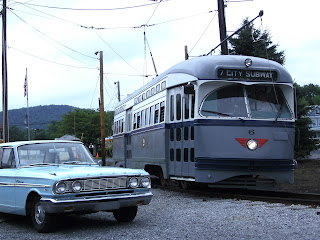With the need to support so many "big" projects and events over the past three months, its easy to forget the myriad of tasks that RTY Maintenance Department volunteers perform to keep our equipment operable and manage acquisition of parts and components that will serve the long term goals of the museum's collection. This report will capture some of these tasks from late August through early September.
Brake Valve Overhaul on STCP #172
These brake valves are an ongoing maintenance headache from the RTY Maintenance Department volunteers. After some frustrating trial and error, Budd Blair and your author finally diagnosed the source of the ongoing problems and what thus far has been a successful intermediate solution.
The Sociedade de Transportes Colectivos do Porto (STCP) not only constructed a number of car bodies in their own shops, but also designed and constructed many of the components that make up a complete car, including, but not limited to truck castings, brake shoes, air compressors, and brake valves. The brake valves function by an internal plate pushing against spring loaded valves that either release or apply the brakes depending upon whether the valve handle is pushed (release) or pulled (apply). The spring loaded valves have an internal cup-shaped gasket that slides against the inside of the piston walls. The following series of photos illustrate the valve construction.
This shows the inside of the main body of the valve with the top cover and main plate removed
This is the back of the brake valve, showing the cylinders that the pistons sit in (these are the two release side pistons)
From left (release side) to right (apply side), these are the pistons, springs, and associated gaskets
This shows the cup-shaped gasket after a typical failure
After investigation, the following was determined to be the sources of the problem:
- Originally, it is believed wax-impregnated leather packing cups were used in the pistons. At some point, these were replaced with rubber gaskets (packing cups) from automobile wheel cylinder parts. The stock on hand was found to have gaskets of two different widths (some too large), some with holes punched off center (causing the packing cup to bind on one side over time), and others dry rotted and cracked. Only acceptable cups were kept in stock after this discovery.
- WABCO brake cylinder grease had been used to lubricate the gaskets. This was found to attack the rubber, causing premature failure. White lithium grease has been substituted since and has given good results to date.
Maintenance Department plans to order correctly sized wax-impregnated leather packing cups to replace the rubber cups at the next servicing, and is also exploring a more common and serviceable pair of brake valves (such as an overhauled pair of GE brake valves) to replace the STCP versions on car #172. (Sister car #249 is planned to retain its STCP valves for the long-term future to ensure the historical integrity of this car).
Repairs were completed on September 15 and since then the car has performed satisfactorily.
Delivery of Brill 27F trucks for Valley Railways #12
On September 25, RTY volunteers Budd Blair, Charlie Wootten, Larry Zilch, David Brightbill, and Matt Nawn took an early morning delivery of a pair of Brill 27F trucks, obtained as the second part of the multi-museum trade of former DCTS Sweeper #09 for Iowa Terminal #3. Acquisition of these trucks completes a nearly three decade search by the museum for suitable vintage, size, and wheelbase trucks for use under the museum's oldest car. Brill trucks of this style and vintage are nearly impossible to obtain complete from any source. While covered in a moderate coat of surface rust, what is most important and made these trucks very valuable is that they are complete except for one pair of brake shoes and motors (which were not part of the trade but the museum has suitable motors on hand for use with these trucks). These trucks is a huge boost to the restoration potential of this unique and much-loved car. Demonstrating just how rare these trucks are, volunteers from another museum already made an informal offer to acquire them (sorry, we are keeping these)! The trucks are currently stored near Buehler Shop, but will soon be moved inside Carbarn #2 once the JTC #311 trucks are moved into Buehler Shop.

It was a very special day for Rockhill Trolley Museum when these cars arrived.
More work on STCP cars
After the delivery and unloading of the 27F trucks, Budd Blair and Matt Nawn performed an inspection and servicing of the controllers on STCP work car C-64 and made adjustments to the pole of STCP #172. Out of sight, but certainly not forgotten, David Brightbill also took advantage of this relatively quiet day by getting some wood varnishing done on interior components of JTC #311.
Both STCP single truck cars get ready to return to Carbarn #2 after some maintenance work.
Every volunteer can make a difference
There is a job for volunteers of every age and skill level. Case in point, on October 13, Matty Nawn (Age 8), Andrew Nawn (Age 6), and Megan Nawn (Age 4) decided (without any suggestion from Dad) to remove accumulated stones and other debris from the former Ohio Public Service trucks displayed outside of the Littlewood Substation while their dad checked on work on NJT PCC Car #10. Even the little jobs can make a difference. The proud crew poses below with their handiwork.
Thank you to each and every one of our volunteers in every department who make a difference!














































.jpg)




_(1024x552).jpg)



_(1024x705).jpg)




